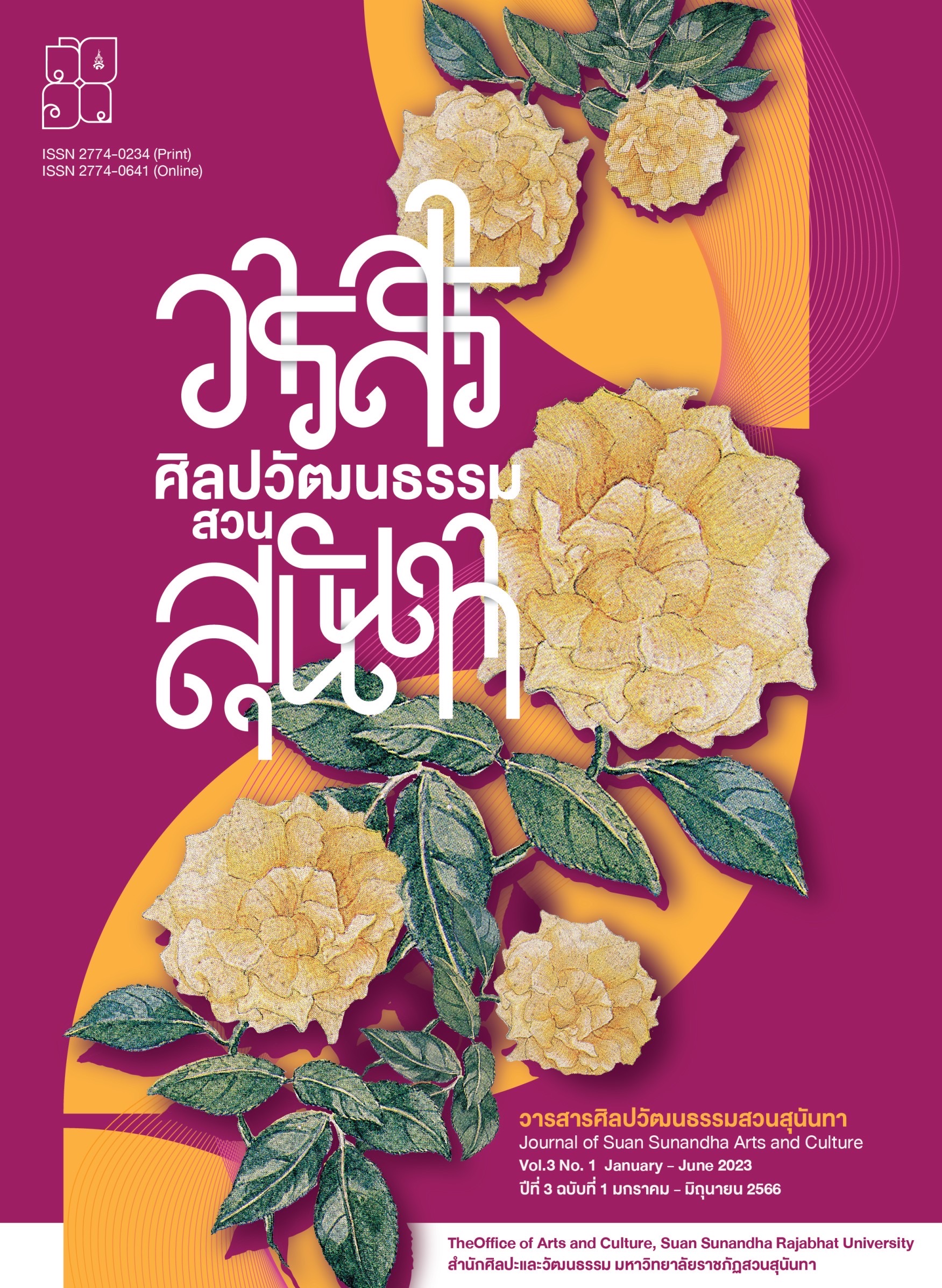THE DEVELOPMENT OF BAI SRI FROM SPUNDBOND FABRIC
Keywords:
Design, The Development, Bai sri, Spunbond FabricAbstract
The objective of this research is to study the process of handicraft of Bai Sri from spundbond fabric and surveying the satisfaction of the target group for the development of Bai Sri from spunbond fabric. By designing the idea of a Bai Sri frame from spunbond fabric in 3 models and experimenting Bai Sri, Bai Sri insert and Thad Hu 3 of each types for the experts consider choosing the right model. Then we used the model that the majority of our experts have chosen to develop the baisri from the spunbond fabric. The product was later surveyed for the satisfaction of the target group consisting of 50 participants. The data was then analyzed by employing frequency, median and percentage. The result of the analysis was found that
- Most of the specialists selected the sketch design 1 for the reason that it had the appropriate proportion for taking into making the Bai Sri. The format 2 was selected for the body of Bai Sri for the reason that it made the differently eye-catching feeling with creative details which suited well with the authors’concept. The format 3 was selected for the Mangda for the reason that it was beautiful and creative in making additional details with the Thai workpiece. Majority of the specialist selected the format 3 for the Tadhoo for the reason that it was delicately beautiful and looked more dimensional.
- The satisfaction of the target group affecting the development of Bai Sri from spundbond fabric was found that in terms of the product, they were satisfied with the meticulousness at the highest level with the median of 4.42. In terms of the value and the use in various ceremonies, they were satisfied at the highest level with the median of 4.36. In terms of the materials, they were satisfied with the appropriateness at the highest level with the median of 4.88. Eventually, in terms of the distribution outlets, they were satisfied with the OTOP shops in the northeastern region at the high level with the median of 4.24.
References
จิตติมา กาญจนปาน. “การประดิษฐ์พานดอกไม้ธูปเทียนแพจากผ้าสปันบอนด์”. โครงงานพิเศษคหกรรมศาสตรบัณฑิต มหาวิทยาลัยเทคโนโลยีราชมงคลพระนคร, 2556.
ราชบัณฑิตยสถาน. พจนานุกรมฉบับราชบัณฑิตยสถาน พ.ศ.2554 เฉลิมพระเกียรติพระบาทสมเด็จพระเจ้าอยู่หัว เนื่องในโอกาสพระราชพิธีมหามงคลเฉลิมพระชนมพรรษา 7 รอบ 5 ธันวาคม 2556. กรุงเทพฯ: ศิริวัฒนาอินเตอร์พร๊นท์ จำกัด, 2554.
ภัทราวุธ ทองแย้ม. บายศรีของสูงที่ทรงคุณค่า. กรุงเทพฯ: แม่บ้าน จำกัด, 2548.
ภัสสรา ทาแท่งทอง และธีรวุฒิ สีสิน. “การประดิษฐ์พานธูปเทียนแพจากผ้าสปันบอนด์ ด้วยเทคนิค โอริงามิ”. โครงงานพิเศษคหกรรมศาสตรบัณฑิต มหาวิทยาลัยเทคโนโลยีราชมงคลพระนคร, 2560.
มณีรัตน์ จันทนะผลิน. งานใบตอง. กรุงเทพฯ: บริษัท อัมรินทร์พริ้นติ้งแอนด์พับลิชชิ่ง จำกัด (มหาชน), 2540.
วุฒิชัย พรหมมณี. “การประดิษฐ์บายศรีอีสานจากซองบะหมี่กึ่งสำเร็จรูป”. โครงงานพิเศษ
คหกรรมศาสตรบัณฑิต มหาวิทยาลัยเทคโนโลยีราชมงคลพระนคร, 2553.
วัชระ อุปรัง และอัษฎาวุธ โกพิมาย. “การประดิษฐ์พานพุ่มจากผ้าสปันบอนด์”. โครงงานพิเศษคหกรรมศาสตรบัณฑิต มหาวิทยาลัยเทคโนโลยีราชมงคลพระนคร, 2557.
Downloads
Published
How to Cite
Issue
Section
License
Copyright (c) 2023 สำนักศิลปะและวัฒนธรรม มหาวิทยาลัยราชภัฏสวนสุนันทา

This work is licensed under a Creative Commons Attribution-NonCommercial-NoDerivatives 4.0 International License.
วารสารศิลปวัฒนธรรมสวนสุนันทา เป็นวารสารในรูปแบบเปิด (Open Access) ผู้ใช้ทั่วไปหรือระบบสารสนเทศของหน่วยงาน ฐานข้อมูลอัตโนมัติ ระบบห้องสมุดอัตโนมัติ สามารถเข้าถึง ดาวน์โหลด เอกสารไฟล์บทความบนเว็บไซต์วารสาร โดยไม่มีค่าใช้จ่ายแต่อย่างใด
ข้อความภายในบทความที่ตีพิมพ์ในวารสารศิลปวัฒนธรรมสวนสุนันทาทั้งหมด รวมถึงรูปภาพประกอบ ตาราง เป็นลิขสิทธิ์ของสำนักศิลปะและวัฒนธรรม มหาวิทยาลัยราชภัฏสวนสุนันทา การนำเนื้อหา ข้อความหรือข้อคิดเห็น รูปภาพ ตาราง ของบทความไปจัดพิมพ์เผยแพร่ในรูปแบบต่าง ๆ เพื่อใช้ประโยชน์ในเชิงพาณิชย์ ต้องได้รับอนุญาตจากกองบรรณาธิการวารสารอย่างเป็นลายลักษณ์อักษรอนุญาตให้สามารถนำไฟล์บทความไปใช้ประโยชน์และเผยแพร่ต่อได้ โดยอยู่ภายใต้เงื่อนไข สัญญาอนุญาตครีเอทีฟคอมมอน (Creative Commons License: CC) และ ต้องแสดงที่มาจากวารสาร – ไม่ใช้เพื่อการค้า – ห้ามแก้ไขดัดแปลง, Attribution-NonCommercial-NoDerivatives 4.0 International (CC BY-NC-ND 4.0)
ข้อความที่ปรากฏในบทความในวารสารเป็นความคิดเห็นส่วนตัวของผู้เขียนแต่ละท่านไม่เกี่ยวข้องกับสำนักศิลปะและวัฒนธรรม มหาวิทยาลัยราชภัฏสวนสุนันทา และบุคลากร คณาจารย์ท่านอื่น ๆ ในราชวิทยาลัยฯแต่อย่างใด ความรับผิดชอบองค์ประกอบทั้งหมดของบทความแต่ละเรื่องเป็นของผู้เขียนแต่ละท่าน หากมีความผิดพลาดใด ๆ ผู้เขียนแต่ละท่านจะรับผิดชอบบทความของตนเอง ตลอดจนความรับผิดชอบด้านเนื้อหาและการตรวจร่างบทความเป็นของผู้เขียน ไม่เกี่ยวข้องกับกองบรรณาธิการ



